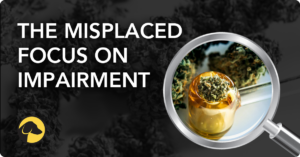
The Risky Connection Between Cannabis Use and Impairment
For decades, employers have relied on workplace drug testing as a risk mitigation tool to help deter drug use and prevent costly incidents. However, with cannabis legalization expanding, so are the use and acceptance of the drug. The connection between the increasing availability of cannabis and the increasing use of cannabis at work creates significant risks and associated costs for employers.
In an attempt to address cannabis use, some legislators and organizations have introduced a series of laws and policies focused on identifying the signs of impairment. Unfortunately, introducing impairment language may actually prevent employers from creating workplace drug testing programs that effectively deter workplace cannabis use and mitigate risk.
THE COSTS OF DRUG USE AT WORK
The costs associated with drug use in the workplace are far-reaching, as they can impact multiple areas such as employee turnover, absenteeism, productivity, and injury costs. According to a study reported by the National Institute on Drug Abuse, employees who tested positive for THC had 55% more industrial accidents, 85% more injuries, and 75% greater absenteeism compared to those who tested negative. The Occupational Safety and Health Administration (OSHA) says employers may save $4 to $6 for every $1 invested in a health and safety program. Workplace drug testing is part of this investment.
It’s critical to consider these and other costs related to data, fiscal, and brand risks when determining the effectiveness and the return on investment of drug testing. Anchoring drug testing policies to deter use is shown to help employers proactively curb incidents and mitigate the costs associated with drug use at work.
THE PURPOSE OF WORKPLACE DRUG TESTING
The primary goal of workplace drug testing is to deter employees from using drugs before or during work. To achieve these goals, employers create comprehensive programs applying drug testing in a range of scenarios across the employment spectrum. Scenarios may include testing during pre-employment, in random selection, or when there’s reasonable suspicion of drug use. Combined, these approaches empower employers to continuously deter use and mitigate risks associated with cannabis use proximate to the workday. With policies focused on prohibiting workday use, the need to determine impairment becomes irrelevant and unnecessary.
THE IMPAIRMENT CHALLENGE
With increased use, discussions around impairment seem to be in constant debate. However, the focus on impairment can unintentionally limit the effectiveness of employers’ drug testing programs for several reasons. First, introducing impairment language shifts the focus from deterrence and may enable the tolerance of some drug use. Second, impairment is difficult to determine because an agreed-upon standard does not exist.
“The main point many people fail to realize is that alcohol had decades, literally decades, of study to get to an impairment standard,” says Barry Sample, toxicology and workforce drug testing expert. “Study data and broad consensus on its outputs are key pieces legislators have been missing as part of determining an impairment standard for cannabis.”
Finally, because of the lack of objective and consistent impairment standards, employers could risk litigation from employees who are penalized based on presumed impairment. In these cases, employees may claim bias because of the subjectivity of determining impairment without standards.
TYING IT ALL TOGETHER
For more than 40 years, employers have relied on workplace drug testing as a risk mitigation tool to effectively deter drug use, help prevent incidents, and identify the presence of drugs in the case of a workplace injury or incident. Laws focused on impairment distract employers from optimizing their testing programs. Contrary to the assumption of these laws, workplace drug testing has never been a measure of impairment – it’s a tool to deter use immediately before or during work hours. And, it’s essential to remember that the goal of deterrence is a zero percent positivity rate during the workday; not a zero tolerance policy related to employee use. For an employer in the era of cannabis legalization, a test that measures only recent use, such as a breath test, will be a more objective measure to help enforce policies and optimize the original intent of drug testing – to deter and detect workday use.
If you’re ready to take a proactive approach to mitigate the risks associated with cannabis use during the workday, we have resources and tools available, including our new ebook. Our team at Hound Labs has been working with employers across the country to implement the HOUND® CANNABIS BREATHALYZER into their drug testing policies. If you would like to learn more about putting this cannabis testing tool to work in your organization, connect with our team.

October 26, 2023
By HOUND LABS
Share












